34 Michelob
Chapter 1: History
Introduction
This Beer is Michelob. It is most commonly known today as Michelob Ultra, a light beer. It is owned by “Anheuser-Busch”, as well as many other brands. It was originally a 4.7% ABV pale lager developed by Adolphus Busch. Production of Michelob began in 1896 as a draught beer for fancy people.1 A draught beer is beer that is sold from a keg rather than a bottle or can. Michelob is the German name for Měcholupy, now in the Czech Republic, where Anton Dreher, a famous brewer, had a brewery. 1.
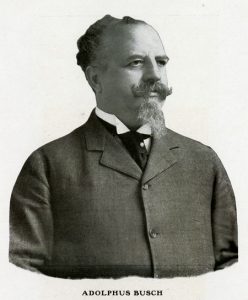
Origins
Originally introduced as an expensive lager sitting at $8 per barrel, this was a beer meant for the people with a little more money.4 Michelob struggled to become a favourite throughout the early to mid 1900’s during the wars. Due to it still being a draught only beer, it was less accessible for the general public to enjoy. Due to inadequate amount of materials to brew Michelob, it struggled to sell during the Second World War.3 Prohibition of course hurt sales as I imagine most people who are struggling to get their hands on beer in the first place, were looking to buy an a more expensive beer. It wasn’t until 1961 that Anheuser created a pasteurized version legal to sell in America. Michelob began selling in a special teardrop shaped bottle that won an award from the Institute of Design in 1962. These bottles were discontinued five years later in favour of traditional bottles to increase efficiency on the product line.4
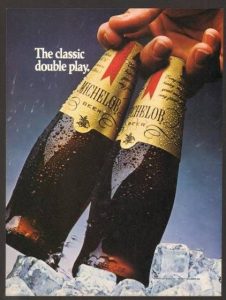
Key Milestones
A line of Michelob titled “Michelob Light” was introduced in 1978 as the demand for more diet beer grew. In 2013 it was listed as one of the nine beers Americans no longer drink by USA Today.5 Sales decline nearly 70% during 2007 and 2012. Despite how poor this sounds, this is specifically the light line of Michelob that was declining, not the brand as a whole. 2007 saw the return of the teardrop bottle for a special limited edition event.4 Michelob Ultra as most people know it by today, was introduced in 2002 as a low carb beer. Michelob has several different types of sub beers that branch off from tradition as they the breweries test new flavours and methods. Today’s catalog of Michelob Ultra features “Pure Gold”, an organic beer, “Amber Max”, a beer crafted to remove gluten, and “Infusions”, featuring many different flavour.2

2. $michelob ultra pure gold: Michelob ultra. Michelob ULTRA Pure Gold | Michelob ULTRA. (n.d.). Retrieved February 5, 2022, from https://www.michelobultra.com/our-beers/ultra-pure-gold/
5. Frohlich, T. C., & Sauter, M. B. (2013, December 10). Nine beers many Americans no longer drink. USA Today. Retrieved February 5, 2022, from https://www.usatoday.com/story/money/business/2013/12/09/beers-we-no-longer-drink/3915505/
3.Gary, G. (2021, August 25). Michelob over time. part III. Beer Et Seq. Retrieved February 5, 2022, from https://www.beeretseq.com/michelob-over-time-part-iii/
4. Miller, S. (2021, August 6). The history behind ten famous beers. Gunaxin. Retrieved February 5, 2022, from https://gunaxin.com/the-history-behind-ten-famous-beers
- Wikimedia Foundation. (2022, January 15). Anheuser-Busch Brands. Wikipedia. Retrieved February 5, 2022, from https://en.wikipedia.org/wiki/Anheuser-Busch_brands
Chapter 2: Industrialization and Globalization
Brewing science and Industrialization
The brand of Michelob itself didn’t really make any groundbreaking achievements due to it being introduced in 1896, far after many advancements in beer were made. However, Michelob’s creator Adolphus Busch is arguably the most influential brewer of that time period, so it would be best to begin there. In an attempt to replicate the the German Bohemian Lager, Busch began brewing Budweiser which was a huge hit. Due to this success he had to develop an idea to transport this excess beer to other places. He then came up with the idea to transport them on refrigerated train cars(Warner, 2010). The American brewing style of ‘lagering’ was introduced in 1818 as scientists discovered more about the composition of yeast, which gave birth to the golden pale lager Michelob down the road, and also is what allowed Busch to transport his beer for long periods of time on trains(Beer Canada, 2019). In the 1860’s, Louis Pasteur discovered the living diseased cells of yeast could be killed by heating the alcohol to a temperature below boiling and then cooling it off(Warner, 2010). Busch was the first brewer to introduce this ‘Pasteurization’ to America, which is the process that allowed Michelob to be sold in bottles in 1961.
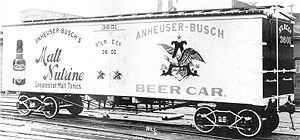
https://en.wikipedia.org/wiki/Refrigerator_car
An example of a refrigerated train car that would be used to transport beer.
Beer Style
Michelob would be best described as an ‘American Lager’, which is to say a pale light lager. This style was introduced by using domestic American ingredients such as corn to try and replicate the German lager. This style is lightly hopped and has a very smooth taste. Michelob tends to be between 4-6% ABV throughout it’s history.(Wikipedia, 2021). As a light lager, Michelob is best served at very cold temperatures (2-40C) in a pilsner glass, designed to show off the colour and the head of the beer(The Beer Glass Guide).

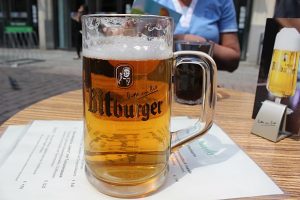
https://thebeergearstore.com/product/michelob-ultra-16oz-attitude-pilsner-glass/ https://en.wikipedia.org/wiki/Lager
It may be difficult to notice, however the American lager(left) is slightly lighter than the German lager(right) in colour due to it having different ingredients.
WW1 and WW2 Era
Michelob struggled significantly during early to mid 1900’s. It was still only available on domestic draft which made it difficult for the beer to be enjoyed by the masses around the world. The shortage of resources such as barely made it more expensive to brew beer during both wars. Brewers used other ingredients such as corn and rice to make up for this and in turn, gave rise to the light beers of America like Michelob(Swinnen, 2011). WW1 had the long term consequence of bringing upon the 18th amendment in America, prohibition. This almost wiped out brewers across America, many of them only surviving by selling soft serve or soda. Prohibition was repealed in 1933 which was great for beer, however less than 10 years later the Second World War repeated the shortage of grains again(Swinnen, 2011). This adapting could also be seen as a benefit for the Michelob brand. The use of corn and rice made Michelob shine as a light beer for an active lifestyle. After struggling to sell as a draught beer during both wars, Michelob was forced to begin selling in cans and bottles in 1961 which brought it to a household name.
Beer Canada. (2019). A Brief History of Beer in Canada. Retrieved from https://www.beercanada.com/beer-101/brief-history-beer-canada
Swinnen, J. F. (Ed.). (2011). The economics of beer. OUP Oxford.
The Beer Glass Guide. (n.d.). Hand Family Companies. Retrieved March 9, 2022, from https://www.handfamilycompanies.com/blog/wp-content/uploads/2015/04/Glassware-Infographic_v2.png.
Warner, A. G. (2010). The evolution of the American brewing industry. Journal of Business Case Studies (JBCS), 6(6).
Wikimedia Foundation. (2021, July 28). American Lager. Wikipedia. Retrieved March 9, 2022, from https://en.wikipedia.org/wiki/American_lager
Chapter 3: Modern Era
Consolidation and Globalization
After the wars the breweries in America decreased significantly but the breweries that stuck around began pumping out more barrels than ever. Mergers took place everywhere that saw small breweries being bought out for their production lines or products themselves by larger breweries. The five largest American breweries’ share in total USA beer production rose from 19 per cent in 1947 to 75 per cent in 1981 (Stack, 2003). Anheuser Busch, the brand that owns Michelob and a large portion of the beers in America was founded in 1852. On July 14, 2008, Anheuser-Busch accepted a $52 billion takeover offer from InBev, a beer conglomerate based in Belgium (Radio, 2018). This is what is known as horizontal integration, a business strategy in which a company takes over another company in the same industry to eliminate competition and diversify their product line. The parent company is now known as AB InBev which now owns 630 brands across 150 countries(Wikipedia, 2022). This takeover saw lots of problems for the passionate Anheuser Busch employees and customers. Hundreds of Busch employees were laid off and the advertising budget, which was a staple of the brand was cut significantly(Radio, 2018). To this day AB InBev remains a giant in the industry, owning a significant amount of the brands on the shelves.
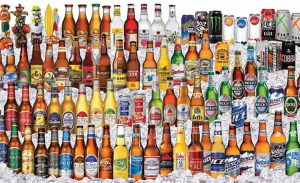
Several of the brands owned by AB InBev
https://www.foodengineeringmag.com/articles/99066-top-100-food-and-beverage-company-highlights-anheuser-busch-inbev
Marketing and Branding
When Michelob was created, it was known as a draught beer for fancy people. When draught moved to bottles, Michelob reinserted itself in to the market with the innovative teardrop bottle. To this day Michelob is considered to be a “super premium” beer, a higher priced beer with higher expectations from the consumers. Brands typically follow five elements: purpose, positioning, promise, personality and identity. Michelob’s and Anheuser Busch’s purpose is to pave the way to innovation in the industry and be inclusive and healthy. Michelob has positioned itself as super premium, low carb, active lifestyle light beer. Its promise is to be the “superior light beer”, sitting at 95 calories and 2.6 grams of carbs per 355ml(Michelob Ultra, 2022). The personality or human characteristics of the brand could be described as sleek, sporty or cool. Michelob stands out with a distinct identity: bold blue colours with a red ribbon, tall sleek skinny cans to stand out on the shelves and low calories labeled on every bottle. Michelob knows its target consumer is the active, health conscious person and preaches to them specifically.
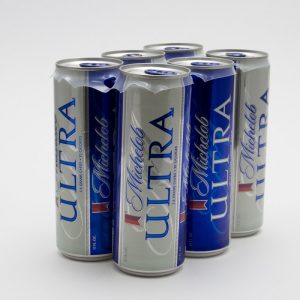
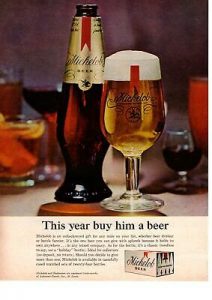 Michelob has always stood out with interesting packaging
Michelob has always stood out with interesting packaging
https://www.pikfly.com/Ale/34212-Michelob-Ultra-12oz-Slim-Can-6-Pack/
https://www.ebay.com/itm/353867455166
Modern Era
Beer follows a product life cycle from development to growth, maturity, then decline. America and Canada are listed as high maturity markets, with Michelob standing as a matured beer. A mature beer has fierce competition and needs to show why their product is unique. The trend Michelob has followed the heaviest is sustainability. Michelob’s “Pure Gold” line is made using 100% solar energy to power the production which is both sustainable and innovative. Michelob is committed to purchasing the Barley from organic farmers and has set up grant programs to help these farmers transition to a greener production saying, “We believe our beer should not only taste good, it should do good, too”(Michelob Ultra, 2022). Michelob is following the non-traditional trend by introducing a line of “Infusions”, beer infused with real fruits for an alternative taste to the beer market. Every Michelob bottle also comes stamped with the symbol for no alcohol consumption while pregnant and urges their consumers to not drink and drive.
Stack M (2003). ‘A Concise History of America’s Brewing Industry’, in Robert Whaples
(ed.), Economic History Net Encyclopedia of Economic and Business History, available at
<http://eh.net/encyclopedia/article/stack.brewing.industry.history.us>.
$superior light beer: Michelob ultra. Superior Light Beer | Michelob ULTRA. (2021). Retrieved April 9, 2022, from https://www.michelobultra.com/our-beers/ultra-light-beer/
Radio, S. L. P. (2018, July 14). AB InBev merger still stings 10 years later. STLPR. Retrieved April 9, 2022, from https://news.stlpublicradio.org/economy-business/2018-07-13/ab-inbev-merger-still-stings-10-years-later
Wikimedia Foundation. (2022, April 2). AB InBev. Wikipedia. Retrieved April 9, 2022, from https://en.wikipedia.org/wiki/AB_InBev

